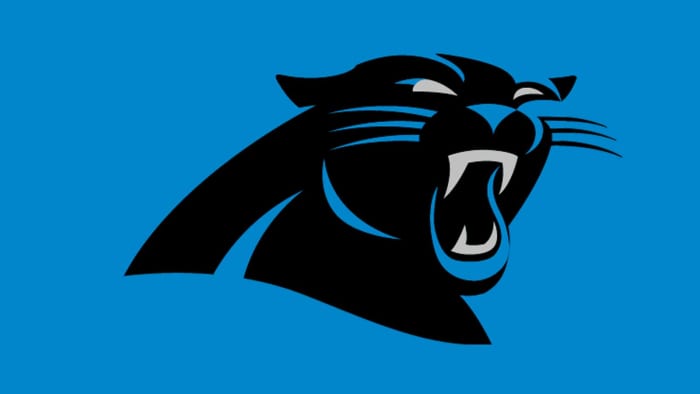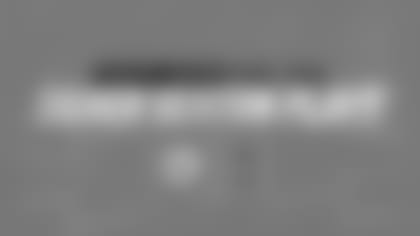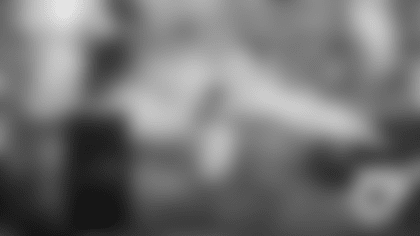It's arguably the most iconic play in Panthers' history in the most dramatic victory the team has ever captured: Jake Delhomme's game-winning 69-yard touchdown pass to Steve Smith on the first play of the second overtime for a 29-23 road win over the St. Louis Rams in a divisional playoff game.
The play illustrated more than any other the unique chemistry between the quarterback and the wide receiver who were recently named to the Panthers' Hall of Honor.
Called "X-Clown," it unfolded on Jan. 10, 2004, and it catapulted Carolina to the NFC championship game in Philadelphia and ultimately to Super Bowl XXXVIII.
The play itself lasted just 10 seconds, but there were countless twists and turns before it clicked, including details unearthed during interviews with four crucial contributors:
- WR Steve Smith Sr., scorer of the iconic TD who played for Carolina from 2001-13
- QB Jake Delhomme, thrower of said TD who played for Carolina from 2003-09
- Head coach John Fox, who led the team from 2002-10
- Offensive coordinator Dan Henning, who directed the unit from 2002-06
SMITH: "It all started in practice. We practiced that play so many times. I ran it too fast and then I ran it too slow. Jake threw it too high, or threw it behind me, threw it perfectly and then I did something wrong. It was always something. We kind of tabled it because we just kept screwing it up."
DELHOMME: "We tried and we couldn't hit it in practice. I was thinking one thing and when I went one way, Steve ran it the other way. It was just one of those. But (offensive coordinator) Dan Henning, I don't know how but he just knew. He kept saying, 'Don't worry about it. Y'all will be fine in the game. It'll happen.' It was hard to recreate exactly how they were going to play it with the scout-team defense.
"We put in X-Clown that week because we saw on film that Cincinnati ran it against them with some success earlier in the season. Chad Johnson ran it and Carson Palmer hit him on it. What I saw and envisioned on film was Chad going to the corner and taking a high angle inside the safety toward the near goalpost. But a high, deep throw. And that's how I would throw it in practice.
"But Steve, he's never admitted this and I've never truly asked him, but Steve always came flat instead of high – and I think it was because Steve was going to do it his way and not Chad Johnson's way. Because remember, they were teammates in junior college. They were teammates and they were buddies – but they also were competitive with each other. Steve is just that way."
HENNING: "To be honest with you, after the first day of practice, there were questions – because it was an unusual route. It's not something you would normally run. You don't normally take the outside receiver and run him down the middle against 2-deep (defenses) – because the safeties will close on him.
"When we saw it on film and we saw Ocho do it (for the Bengals against the Rams' Cover-2 defense) – well, at that time I guess he was still Chad Johnson – when we saw him do it, we saw what they were trying to get done. It really didn't become 2-deep anymore. If you could get behind the corner quick enough and get the safety turned, we knew it could be a big play."
We tried and we couldn't hit it in practice. I was thinking one thing and when I went one way, Steve ran it the other way. It was just one of those. But (offensive coordinator) Dan Henning, I don’t know how but he just knew. He kept saying, ‘Don’t worry about it. Y’all will be fine in the game. It’ll happen.' Jake Delhomme

The dynamic Rams, featuring tons of star power on offense, led the NFC in scoring that season with 27.9 points per game. They also entered the playoffs riding a 14-game home winning streak at the Edward Jones Dome.
The Panthers were top 10 on defense in both yards and points allowed. Offensively, Carolina was right in the middle of the pack during the regular season. They had generated a lot of momentum with a 29-10 victory over Dallas in the wild card round but were still considered heavy underdogs.
FOX: "The Rams were super, super explosive on offense. But we were very competitive on defense, so we felt pretty good about everything going into the game. Actually, for three quarters we throttled 'em pretty good. We had a bit of a lead and then they came roaring back.
"There was a fourth-and-4 and they picked it up, and that was a turning point in the game. They came back to tie the game. It went back and forth. Then in the first overtime, John Kasay kicked a field goal, and I thought we had won the game. But they called delay of game, believe it or not. (And after being moved back 5 yards, Kasay subsequently missed a 45-yard field-goal attempt). So we went back at it again."
HENNING: "The game went back and forth to such an extent as no other game I've ever been involved in. There was a time when we won the game and they took it away from us. We kicked a field goal and they said time had run out – but the time had run out because they, the officials, didn't stop the clock to switch the balls. And John kicked the field goal and we all thought we had it won.
"Then they moved us back five yards and John had to try to kick it again. Whatever it was, after that point in the game, there became a determination about our team that was really discernible. You could cut it with a knife. It was both our offense and our defense. I mean, I don't want to demean them – but they played above their heads for the rest of the game from that point on."
Smith even got gouged in the eye in the fourth quarter, forcing him to wear a visor for the rest of the game.
SMITH: "Travis Fisher (of the Rams) – he was a corner from Central Florida. He was pressed up and he went to jam me. He jammed me in my eye. I was having a hard time seeing, so they put the visor on me. There were a lot of things going on in that game that just weren't supposed to happen."
HENNING: "We went through the first overtime, back and forth. And then when they stopped the clock and got rearranged for double-overtime, there was a period of time that you don't usually have during a game. And the conversation between myself and Jake came up about this play.
"I said, 'Jake, what do you see? How far over is the safety going?' And he says, 'They're really trying to cover over the top.' They were a heavy Cover-2 team. That's why we had the play in in the first place. They were trying to cover Steve over the top, so he wouldn't go by the short guy and catch the ball in the hole. Because if he catches the ball in the hole, nobody's going to stop him. So basically they were trying to cheat the coverage and double-team Steve – play him from the inside out and then have the safety over the top of him, so we wouldn't hit him in the hole there.
"Well, Jake then went to Steve and explained that to him. And Steve says, 'Hey, I'll turn that guy. I'll go inside and up and turn that guy.' So Jake comes back to me and says, 'He thinks he can do it.' And I said, 'OK, go for it.'"
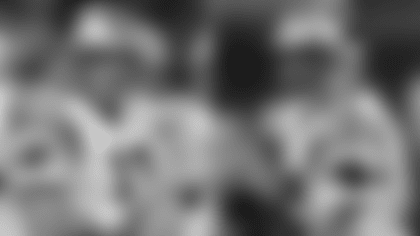
DELHOMME: "We ran it for a big first down earlier in the game (a 36-yard connection early in the fourth quarter). Then it was the first play of the double-overtime. It was third-and-long.
"We called it and you knew you were going to get Cover-2, or Tampa-2. Everybody knew it. … I dropped back, pumped one way just a little bit – not much of a pump, but just enough to try to keep the strong-side safety in his position. (Rams safety Jason) Sehorn was on the other side, and Steve was going to get across him. So I threw it, and there was just a big cavity (in their defense). It was just perfect timing."
SMITH: "We ran it twice against the Rams. And the second time, we weren't running it for a game-winning touchdown; we were running it to move down the field to possibly get into field goal range for Kasay. We didn't anticipate a 69-yard touchdown."
FOX: "It's third-and-long and they're going to get good field position if we don't pick it up. I think everybody was just hoping we would just get the first down, just to get positive field position. And all of a sudden, it went the distance in one play."
HENNING: "That's the first play coming out of the second overtime. And the reason for that is these guys, when they told you they could do it, you listened. Now I had a little barometer that I used with Jake. If we called something and he had a little question, I would ask him, 'What are you thinking?' If he told you he had a strong feeling about something, you went with it.
"Now Steve would tell you he could get open on anything. But the fact that there was extra time there, and Jake and he talked about it, there was no question that Steve knew what was going to be done. And if he catches the ball, the other safety is going over the top over Moose on the other side. So if he turns that safety on our left side, if he turns his shoulders once Steve gives him that move, it's over. And that's what happened. Steve got inside the first guy and started down the field, and he threw this guy a little head-and-shoulder fake, and he turned because he thought he was going deep. And Steve went right behind his back there and Jake put the ball perfect.
"It was instant. We just went into the second overtime. People probably went and took a leak and got another drink – and now the game was over."
I think everybody was just hoping we would just get the first down, just to get positive field position. And all of a sudden, it went the distance in one play. John Fox
DELHOMME: "Earlier in the game, I knew the angle Steve had taken. It was not a line shot (of a throw). It was more of a '2 ball' in Dan Henning terminology. There was a '1,' which was a line; then a '2' that has a little more of an arc in it; and a '3,' which was up and down. So it was a '2 ball,' according to Dan.
"So I threw it and we hit it. And Dan was right. It was easier in the game than it was in practice. Because you saw it. Steve went to the corner, Sehorn widened – and it wasn't like we were trying to hit a home run. We were just trying to get the first down.
"But I was able to hit him dead on in stride, and Sehorn had no chance. I didn't know (it was a touchdown) at first. I knew we had the first down, but you never knew with Steve. If Steve had any kind of space, we all knew it could be a house call. Sehorn, I think that was his last game, his last play ever – and Steve was just on the cusp of a Hall of Fame career."
HENNING: "If you give Steve the ball in that position in the secondary, six out of 10 times he's scoring. He's the best guy with the ball in his hands that I ever coached as a receiver."
SMITH: "The second time we ran the play, they played a different zone coverage that gave us a little more room. I shortened it up and ran it at a different angle to more hit it as a post versus the clown. It was a bigger play the second time because of the variation in the route. And for me, I would never run the same route the exact same way. That's one of the reasons it always got screwed up in practice.
"Probably the third step after I caught it, I realized I might score. When I went up to get it, I leaped and I wasn't sure how far the safety was out of position. I was anticipating a big hit. When I caught it, I thought I was going to get smacked, so I was going to brace myself.
"Then there was no one there. I just took off running. I just was thinking to myself, 'I can't get caught, I can't get caught.' Then when I realized I was gone – it never got on film – but I think I puked after that, just all the emotions and all that stuff. I was literally in the end zone just like, 'Did we?' And everyone was like, 'We won!' I was like, 'Are you sure?'"
Then when I realized I was gone – it never got on film – but I think I puked after that, just all the emotions and all that stuff. Steve Smith
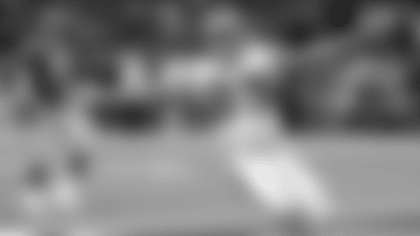
DELHOMME: "It was our season. We were a team of destiny."
FOX: "We called it X-Clown to make the safety look like a clown. I ran into Jason Sehorn (recently). This subject didn't come up. That's one of those things where when I see him once every three years, I'm not bringing this one up.
"You compete and along the way you meet a lot of different coaches and players. There's always a special place (for them) when you share great moments, and I went to a Super Bowl with Jason in New York. But you know, when it's your team doing it (against him), it's not all bad."
HENNING: "It was one of the most famous plays I've ever been around."
SMITH: "In my career here, that's the play that everyone wants to talk about. I hear about X-Clown a ton.
"It's one of the most remarkable things about football. Sometimes the plays that you think are your go-to plays don't end up that way. And sometimes the plays you've put less value on end up being your best plays."


